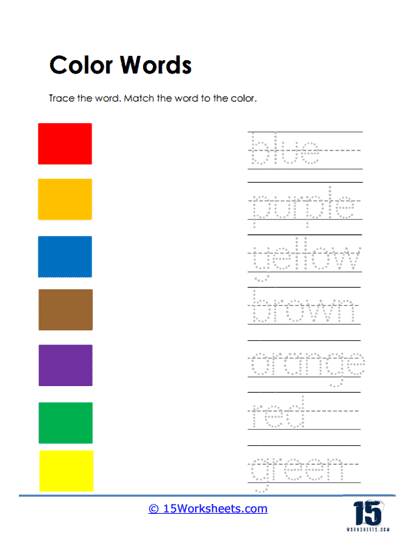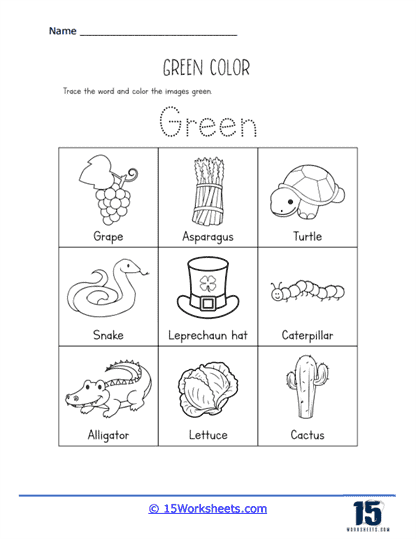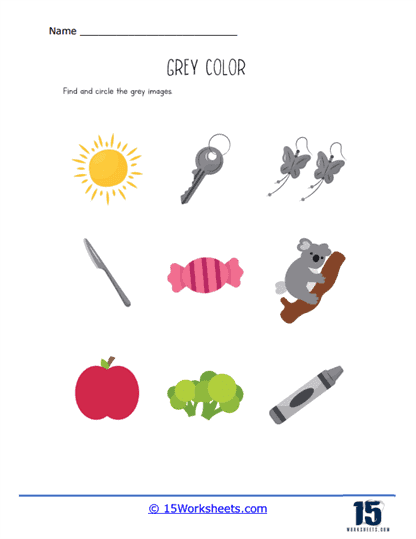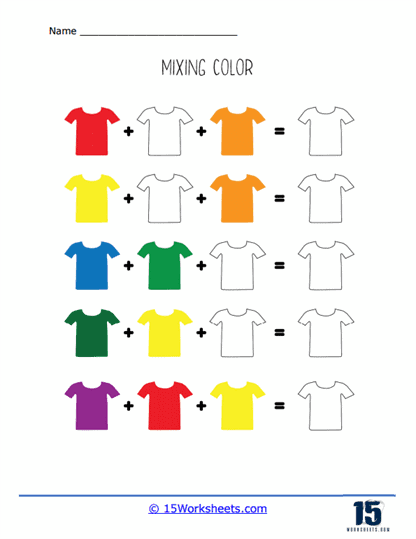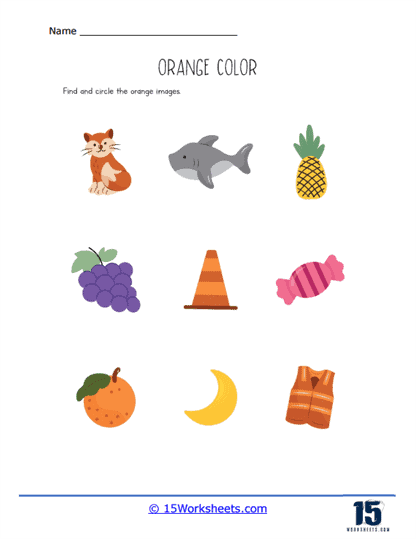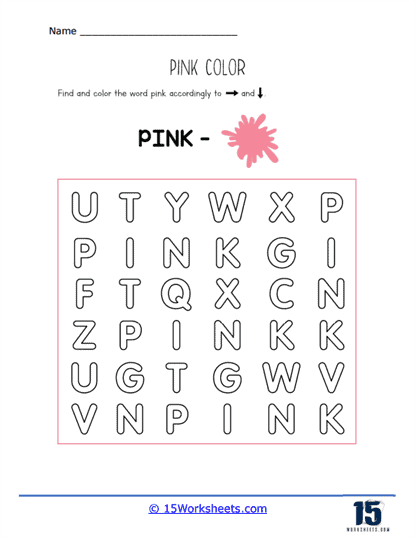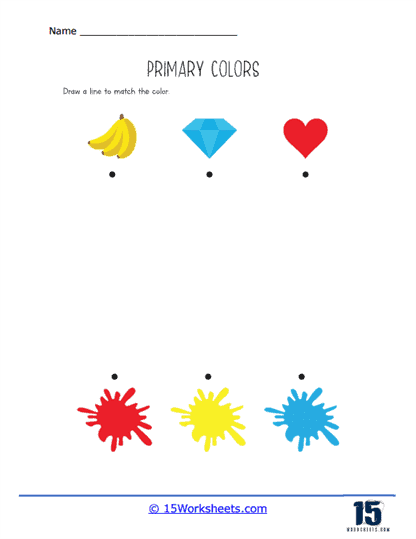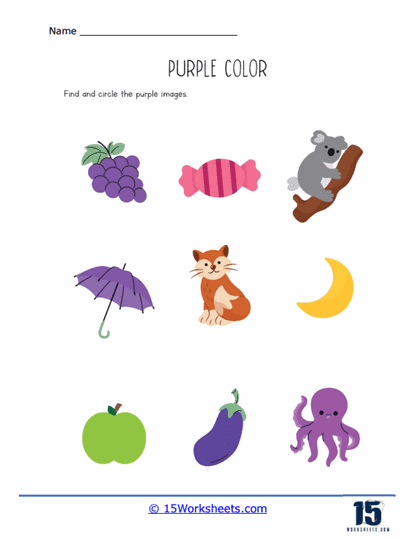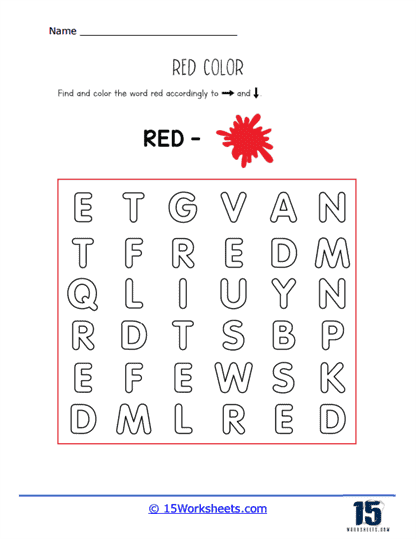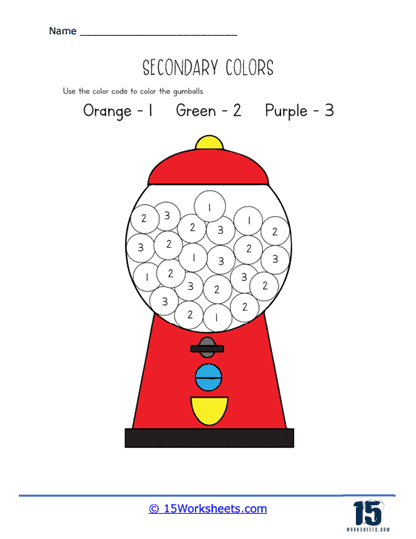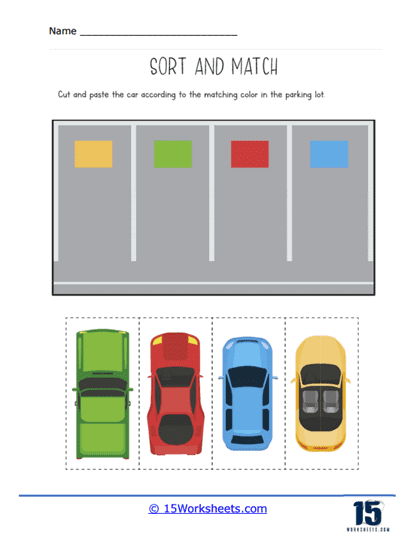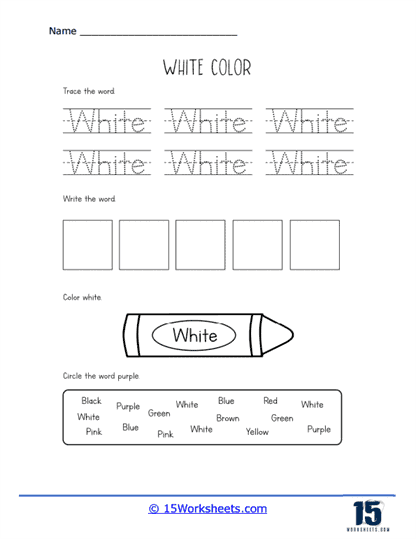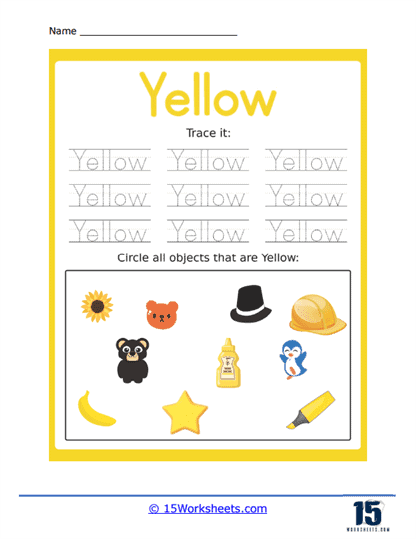Colors Worksheets
All About These 15 Worksheets
Picture this: a classroom alive with the joyful chaos of young minds arguing passionately over whether turquoise is really a blue or a green. That’s the magic of the Colors worksheets. They’re more than just exercises in naming “red” and “blue”-they’re cleverly disguised developmental tools, sharpening everything from cognitive skills to fine motor finesse. It’s like sneaking spinach into mac and cheese, only with markers.
Children naturally gravitate toward color like moths to a lava lamp. These worksheets take that instinct and run with it-into a full sprint of engaging activities. From tracing letters (hello, handwriting practice) to color-matching tasks (so long, chaos theory), the activities look like play but are secretly building the kind of skills that will make future math homework a little less terrifying.
When a child traces the word “purple,” two things happen: they learn how to spell purple and also realize it’s not just a grape flavor. This simple combo of visuals and language gently builds early literacy, turning each scribble into a stepping stone toward fluent reading-and possibly future arguments over whether fuchsia is a real word.
With “find the red apple” exercises, kids sharpen their visual discrimination like tiny detectives. Add in a few cut-and-paste pages and suddenly we’re developing spatial awareness and hand-eye coordination. Bonus: glue sticks become less of a mystery and more of a purposeful tool (we hope).
Let’s not forget the science of it all. Mixing blue and yellow to get green isn’t just fun-it’s an early foray into cause and effect. Color theory lessons, creative coloring pages, and vocabulary-rich naming tasks all blend into a Technicolor toolkit. At the end of the day, these worksheets turn learning into a journey of joyful messiness, just the way childhood should be.
A Look At the Collection
From the mysterious depths of Black to the sunny cheerfulness of Yellow, these worksheets are designed to make color recognition an engaging experience. Students will encounter a spectrum of activities that not only teach them about colors but also tickle their funny bones.
In the realm of Primary Colors, students meet the foundational trio: Red, Blue, and Yellow. Through activities like “Pails of Primary Colors” and “Crayons Need Color,” they learn that mixing these hues can lead to surprising results-like discovering that Red and Blue don’t make a new superhero, but rather the color Purple. The Mixing Colors worksheets further this exploration, encouraging students to become mini color scientists, experimenting with combinations to see what new shades emerge.
As students progress, they delve into Secondary Colors, where the magic of mixing truly comes alive. Worksheets like “Purple Tulip” and “Orange Shoes” challenge them to identify and create new colors, reinforcing their understanding of how colors interact. Meanwhile, the Sort and Match Colors activities turn students into color detectives, sorting through a kaleidoscope of objects to find matching hues, all while honing their critical thinking skills.
Beyond the basics, the Learning Colors and Color Words worksheets expand students’ vocabulary and comprehension. They’ll trace, write, and unscramble color names, turning them into word wizards with a colorful twist. And let’s not forget the Coloring Pages, where creativity runs wild, and students can bring their imaginations to life with every crayon stroke. By the end of their journey, students won’t just know their colors-they’ll have laughed, learned, and perhaps even painted their way to becoming budding artists.
Why Is Learning Your Colors Important?
Why is learning your colors such an essential part of early childhood development? The simple act of recognizing colors goes far beyond just knowing the difference between red, blue, or yellow. It touches almost every aspect of a child’s growth, from their cognitive abilities to their social interactions, and even their self-esteem. Mastering colors serves as one of the building blocks for many other foundational skills. Understanding the significance of color recognition can shed light on how it contributes to a child’s success-not only in their early years but also as they progress in life.
Cognitive Development
At the heart of learning colors lies cognitive development. The ability to recognize and differentiate colors is a fundamental cognitive skill that helps children navigate the world around them. By understanding that objects can be classified based on their color, children develop essential categorization skills. These cognitive processes allow them to classify, compare, and contrast items, which is a precursor to higher-level thinking. For instance, when a child identifies a red apple versus a green one, they are not just learning colors-they are learning to observe, compare, and differentiate between two objects. This cognitive ability to recognize patterns and differences is crucial for future learning in areas like science, where observation and classification are key components of the scientific method.
Language Development
Colors also play a crucial role in language development. As children begin to learn the names of different colors, they naturally expand their vocabulary. Every time a child points out a “blue sky” or asks for the “green crayon,” they are building language skills that enhance their ability to communicate more effectively about the world around them. Learning color names provides an excellent opportunity for children to practice verbalizing their thoughts, which fosters communication. In conversations, a child who can accurately describe their environment is able to participate more fully, whether it’s explaining what they see in a picture or describing their favorite toy. This early language development lays the groundwork for more complex communication skills, enhancing both comprehension and expression.
Visual Perception
Visual perception is another critical area of development that benefits from learning colors. Identifying and differentiating between colors sharpens a child’s ability to interpret visual information, a skill that becomes increasingly important as they progress in school. For example, visual perception is necessary for reading and writing, as children must be able to distinguish letters, numbers, and symbols. Color recognition aids in this process, helping young learners recognize visual patterns, which is key in understanding how words and sentences are structured. By developing strong visual perception skills early on, children are better prepared for the demands of reading and writing, where the ability to discern fine details is crucial.
Early Math Skills
Though it might not seem obvious at first, learning colors lays a strong foundation for early math skills. Sorting objects by color, counting how many red blocks there are, or recognizing patterns made up of different colored shapes are all early math activities. These simple tasks develop a child’s ability to organize and classify, which are essential skills in mathematics. Understanding patterns and sequences-whether in colors or numbers-paves the way for problem-solving and critical thinking. As children move forward in their education, these skills will be essential in subjects like algebra and geometry, where recognizing patterns and relationships is key to understanding mathematical concepts.
Creativity and Self-Expression
Colors are also a gateway to creativity and self-expression. Once children begin to recognize and use colors, a whole new world of artistic possibility opens up to them. Whether they are painting, coloring, or designing, children use color as a tool to express themselves. Art activities that encourage children to mix and match colors help foster their imagination and creativity. As they experiment with different combinations, they begin to understand how colors can convey emotions or tell a story. Through this process, children develop their own unique artistic style, which enhances their ability to think creatively-a skill that will benefit them in all areas of life.
Social Skills
Social interactions also improve when children learn their colors. Many group activities, whether in a classroom setting or at play, require some understanding of colors. For example, a teacher might ask the class to sort objects by color or to collaborate on a project that involves color recognition. Children who can accurately identify colors are better equipped to participate in these activities, promoting teamwork and cooperation. Effective communication during play also improves when children can describe their actions using color terms, such as “pass me the blue block” or “I want the red marker.” This ability to articulate their thoughts clearly strengthens their social skills and helps them navigate social situations with greater ease.
Following Instructions
As children learn to recognize and name colors, they become better at following instructions that involve color-based tasks. Whether it’s a game that requires them to “find all the green objects” or a coloring activity where they are asked to “color the sky blue,” following color-coded directions becomes a way to practice listening and comprehension. This skill is especially important as children enter formal education settings, where following multi-step instructions is often required. Being able to understand and execute these directions with precision helps children feel more capable and responsible, promoting independence and confidence in their abilities.
How To Teach Kids Their Colors
Teaching children their colors can be a joyful and rewarding experience, filled with creativity, discovery, and connection. However, like most fundamental skills, it requires a thoughtful approach, patience, and consistent reinforcement. Colors are among the first aspects of the world that children begin to recognize and understand, and helping them master this skill opens the door to enhanced cognitive development, improved language abilities, and even a stronger sense of self-expression. To make this process both effective and enjoyable, here are some expanded strategies for teaching kids their colors.
Start with Basic Colors
When introducing colors to young children, simplicity is key. Begin with the basics-the primary colors of red, blue, and yellow. These bold, distinct colors are easiest for children to recognize and differentiate. Focusing on a small group of colors initially helps to avoid overwhelming your child, allowing them to grasp the concept of color one step at a time. Once they are comfortable with the primary colors, gradually introduce secondary colors such as green, orange, and purple. These colors, formed by mixing primary hues, can be introduced through activities that encourage color blending, adding an exciting, hands-on element to learning. Starting with the foundational colors sets the stage for your child to build a broader color vocabulary as they explore the spectrum of shades and hues.
Use Everyday Objects
One of the most effective ways to teach colors is by integrating them into your daily routines. Children learn best when concepts are connected to real-life experiences, so take advantage of the objects around you. Point out colors during everyday activities-whether it’s talking about the blue sky, their red shirt, or the green apples at snack time. These small moments of color identification are powerful teaching opportunities because they connect the abstract concept of color with tangible objects in the child’s environment. As children begin to associate colors with the things they interact with daily, their understanding deepens, making the learning process feel natural and engaging. You could even make color identification a part of your morning routine by asking your child to name the colors of their breakfast items or the clothes they choose to wear for the day.
Play Color Games
Turning learning into a game not only makes the process more enjoyable but also helps solidify color knowledge through repetition and interaction. Games such as “I Spy” are particularly effective. Ask your child to “spy” something of a specific color-“I spy something green!”-and watch them scan the room, actively engaging in the learning process. You could also create sorting games where your child groups toys or objects by color, which reinforces color recognition and organizational skills. For instance, they might sort their Lego blocks into piles of blue, red, and yellow or group different colored fruits while grocery shopping. These playful, hands-on activities capture children’s attention and encourage active participation, ensuring that they are learning while having fun.
Read Books About Colors
Children’s books offer another fantastic opportunity for color exploration. Reading books that focus on colors not only reinforces color recognition but also enriches language development. Books with vibrant illustrations captivate young minds, making it easier for them to connect the color words they hear with the images they see. Picture books like Brown Bear, Brown Bear, What Do You See? or The Day the Crayons Quit are great choices because they center around colors in a narrative context, helping children grasp the concept while enjoying a story. Reading together also gives you the opportunity to ask questions and encourage discussion-“What color is the bear?” or “Can you find the yellow duck?” This interactive reading builds not only color knowledge but also enhances their vocabulary and listening skills.
Use Color Flashcards
Flashcards are another effective tool for color learning. You can either purchase ready-made cards or create your own using construction paper and markers. The key is to keep the experience interactive. Hold up a card and ask your child to name the color or point to objects in the room that match the color on the card. Flashcards provide a focused, repetitive practice that can be useful for reinforcing what your child has already learned. For more advanced learners, you can introduce shades and variations-like light blue versus dark blue-to add complexity to the task. To make the learning process more dynamic, you could even incorporate a game element, such as timing how many flashcards your child can correctly identify in a minute or playing a matching game where they pair the cards with objects of the same color around the house.
Coloring and Painting Activities
Art is a natural avenue for children to explore colors. Providing your child with crayons, markers, or paint encourages them to experiment with different colors as they bring their creativity to life. Discuss the colors they are using as they draw or paint-ask questions like, “What color are you using for the tree?” or “Can you show me how to make purple by mixing red and blue?” These activities not only reinforce color recognition but also help children learn about color relationships, such as complementary and contrasting colors. Beyond recognition, coloring strengthens fine motor skills, as children use their hands to carefully control brushes and crayons, developing essential coordination and precision for writing and other tasks.
Sing Color Songs
Music is a powerful educational tool, and songs about colors provide an auditory learning experience that is fun and memorable. Singing simple songs, such as “The Rainbow Song” or “Red, Yellow, Green, and Blue,” reinforces color recognition through repetition and rhythm. Music helps encode information in the brain, making it easier for children to remember what they’ve learned. These songs often come with movements or actions, turning color learning into a multi-sensory experience. Encouraging your child to sing along and act out the colors with you can turn learning into a lively, enjoyable bonding activity. Even on car rides or during quiet times, a quick color song can reinforce the day’s lessons.
Color-Themed Days
Taking a creative approach, you can organize color-themed days to immerse your child in one specific color at a time. For example, if it’s a “red day,” have your child wear red clothes, eat red foods like strawberries or tomatoes, and point out red objects throughout the day. This method not only intensifies focus on one color but also makes learning feel like a special event. You can also take the opportunity to include fun, hands-on activities like baking cupcakes with red frosting or going on a “red treasure hunt” around the house or neighborhood. By dedicating a day to each color, you give your child the chance to fully absorb and interact with that color in a meaningful and memorable way.
Be Patient and Consistent
While teaching colors is an exciting journey, it’s important to remember that every child learns at their own pace. Mastering colors can take time, and consistency is key to helping your child retain what they learn. Use everyday moments to reinforce color knowledge in a casual and pressure-free way, whether you’re pointing out colors at the grocery store or asking about the colors of toys during playtime. Celebrate small victories and milestones to keep your child motivated, but remain patient if progress is slow. Repetition and daily practice will lead to mastery, even if it doesn’t happen overnight.




